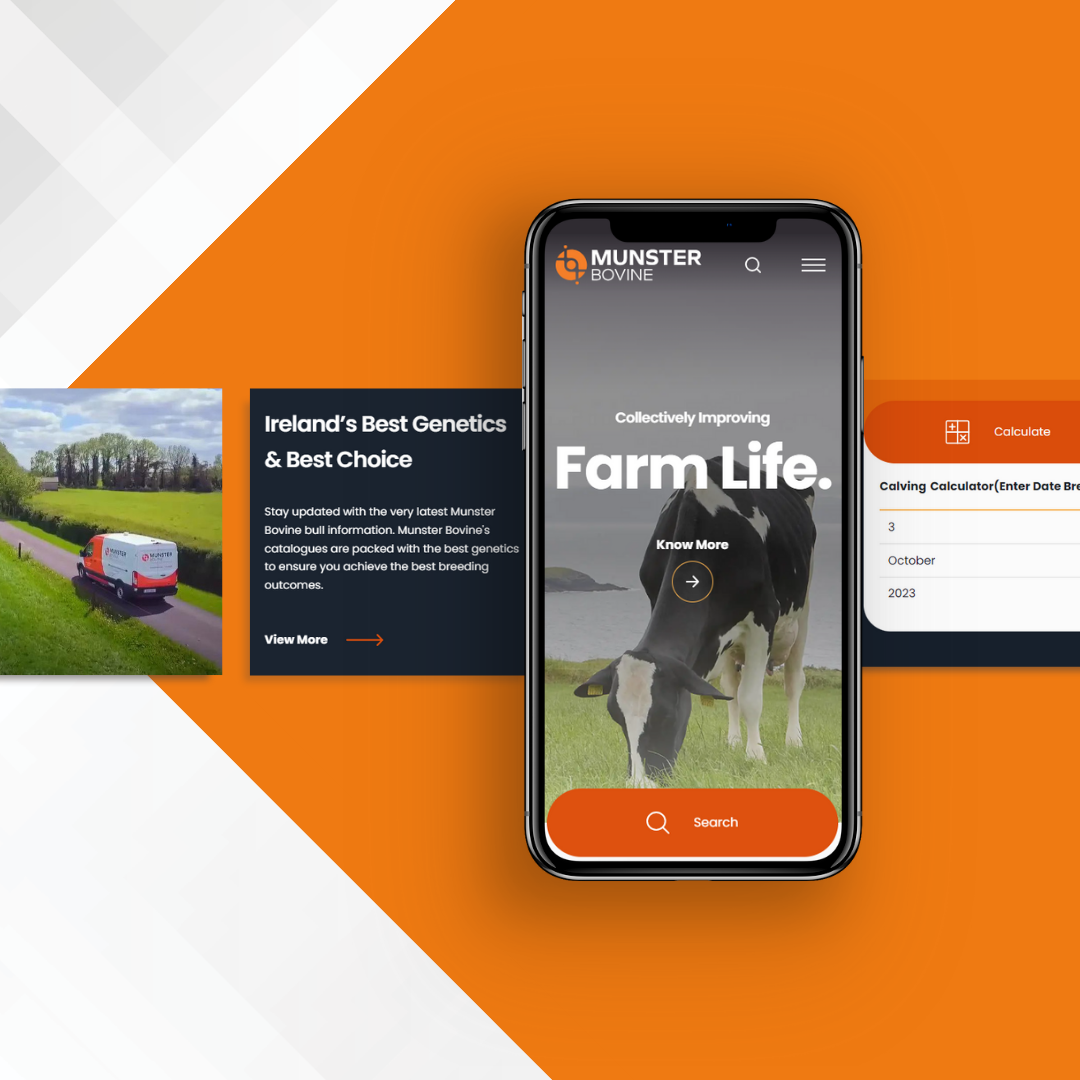News
Successful Cow Housing System Guide
Housing for cows:
With the advent of Selective Dry Cow Therapy, there is a demand for one cubicle per cow in our housing systems. The theory is that this creates an opportunity for every cow to lie down in a clean bed and limit the number of cows that lie in dirty areas of the house. Also, the more floor space and access the cows have the cleaner they are, as cows can move freely and avoid dunging on each other and near their beds. In practice, cows will always choose to lie in the most comfortable spots. Cows are highly motivated to lie down for approximately 12 hours per day and have a strong behavioural need to rest. The more the cows lie down, the more they ruminate, and less time is spent on their feet reducing wear and tear and limiting lameness.
However, not all cubicles are equal, and some systems offer far less comfort to the cow or are designed and installed in such a way that the cow’s ability to use them is impaired. Poorly designed and uncomfortable cubicle systems lead to dirtier cows, more standing time, poor feed and water access and can contribute to increased mastitis, lameness, and body condition loss.
The problem that is a cubicle:
Cubicle housing is the most common system of housing for dairy cows in Ireland. Most cubicles are fitted to make the most of the space available and reduce the cost per bed, with a limited view on cow access to feed barriers, lying time, cow flow, cow cleanliness, and potential for injury in the system.
The common limitations to a cubicle are lack of lunge space, lack of a soft bed, incorrectly placed neck rail, and limited ventilation at the level of the cow’s nose. Lunge space, which is the distance from the front of the mat/mattress/brisket board to the nearest forward obstruction, needs to be greater than 70 cm to allow a cow to swing her head forward to counterbalance her back legs when getting up. Most cubicle systems are installed too close to walls or have bars at chin and head level that restrict movement. Cows must put their head to one side, hence the wide cubicle partition loops, resulting in a cow rising diagonally and depositing manure at the rear of the cubicle. (Fig 1)
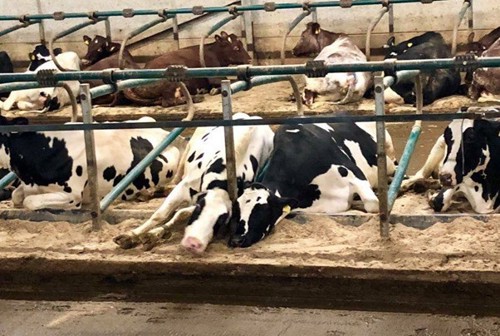
Not all beds are equally soft. As a rule, deep bedded systems using sand, straw, or compost work best but are impractical in poorly ventilated houses or too expensive for slurry management in Ireland. Mattresses provide the next option for bedding, however mattress depth and the nature of the material they are made from will determine the comfort. In research trials, foam rubber mattresses were ranked above rubber crumb mats, which were ranked above water beds. Mats are a poor fifth option, with varying levels of comfort and often being little better than an insulator over concrete. Additional bedding material can compensate to some extent. Every extra kilogram of bedding material such as sawdust or chopped straw will add extra minutes of lying time and keep the cow cleaner. The value of a more expensive mattress system is hard to appreciate as the effect is medium to long term, and the tendency is to accept a cheaper option rather than look at the long- term cow benefit.
Neck rail position has been erroneously used as a method to maintain a cleaner the bed surface by keeping cows closer to the kerb or heelstone in a cubicle. Incorrect neck rail positioning leads to reduced use of the cubicle, cows perching, and reduced lying times. Neck rails should be positioned over a brisket board, 210-220 cms from the kerb measured diagonally. The cow should not touch the neck rail when standing with all four feet on the cubicle bed. The most important positioning tool is a brisket board. A rounded board or pipe at the front of the bed, not more than 10 cm high and 170-180 cms from the kerb depending on cow size, will guide the cow where to lie and stand. A brisket board will establish a safer lunge space for the cow in a short cubicle bed.
In all systems, all cows will lie down eventually if there are enough beds. The quality of design and comfort will determine how long cows will lie down and whether they will meet their 12-14 hour rest requirement.
It doesn’t make financial sense to rebuild an entire cubicle system. Improving mattress quality, adjusting the neck rail, or retrofitting a cranked neck rail, installing a comfortable brisket board, adding bedding, and removing restrictions to lunge space will improve a limited system.
Feed access:
Lines of cubicles are arrayed parallel to a feed barrier with throughways between the cubicle rows to allow access. Parallel systems have two, three, or four rows of cubicles serviced by a single feed barrier. A two-row system has two rows of cubicles parallel to a single feed barrier, three-row system has three rows parallel to a single feed barrier, and so on. (Fig. 2)
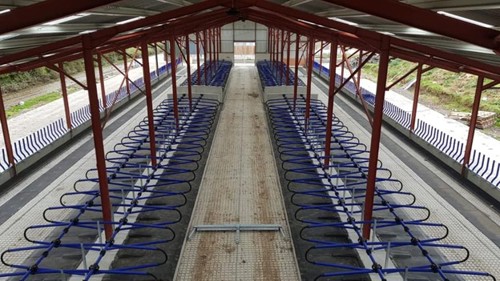
A simple rule is seven cows can feed together in a single 4.7 m standard bay. In a two-row system there is one feed space per cow at 100% stocking rate. In a three-row system there is one feed space to 1.5 cows. Cows feed in groups and in sheds with limited feed space, cows will compete aggressively when new feed is delivered.
Having feed present all-day does not compensate for lack of feed space, as all feed will be sorted over the day and subordinate cows will eat less feed with a lower energy content. Less dominant cows eat lower palatability feeds to avoid dominant cows. From a practical perspective, this means that the construction of pens with three or more rows of cubicles per feed bunk should be avoided, because these typically limit feed bunk space to 40 to 45 cm per cow or less with 100% stall stocking.
Irish seasonal dry cow systems that depend on ad-lib grass silage need control systems to manage body condition. Over-conditioned cows need to be limit fed, while under-conditioned cows need additional feed and unlimited access. Overstocking cows on a feed barrier will lead to aggressive competition and higher risk of disproportionate numbers of individual cows losing or gaining weight. For ‘risk’ cows, cows that are close to calving, cows with low body scores, lame cows and fresh cows, there should be a minimum feed space to allow simultaneous feeding (≥76 cm per cow) to optimize health and production. More feed barrier length allows more feed to be put out, more access for less competitive cows at feed out, and more opportunity to group cows and manage intakes. Lack of feed space is probably the most common constraint on Irish farms that increases the risk of transition disease events.
To achieve the maximum number of cubicles in a row, throughway space is often sacrificed. Throughways are convenient sites for water troughs and cow brushes. However, cow house builders rarely think in cow sizes. A cow is 2.5-3 metres long from tailhead to nose-tip. Throughways and access passageways are generally too narrow. Once there is a water trough in a throughway, no cow can pass if others are drinking, unless the width of the passage is greater than 3.5 metres. This leads to more competitive stressful events and restricted cow flow to beds and feed. Also, increasing the alley width at the feed barrier to 4.5 m - 5 m increases feed access as cows can walk freely behind feeding cows. The other advantage of more floor area is a much cleaner system. While to initial cost of concrete to create space may appear prohibitive, over the lifetime of a shed the health and welfare benefits outweigh the initial cost. (Fig 3).
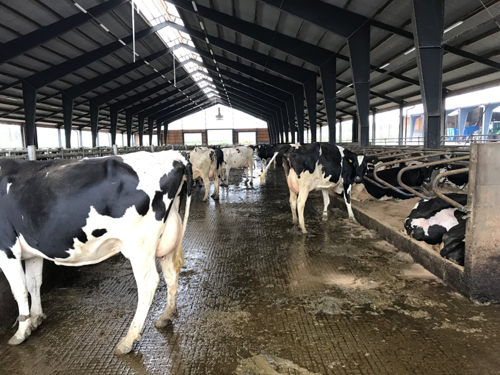
Some cubicle systems are arrayed perpendicular to the feed barrier and in most of these systems, the cubicle access passages end in a dead-end, allowing no escape routes or circulation. Feed space is restricted by fault of the design, i.e., if the cubicle row length exceeds the barrier length, feed space can be reduced to less than one feed space per two cows in a multi-row perpendicular system.
Water access:
Cows should be afforded multiple drinking points in a group to avoid competition. One drinking point per 20 cows, water pressure of 20 litres per minute, and regular cleaning of water troughs is optimal. At least have two water points per group of 20 – 60 cows. Water troughs should be checked daily for filling pressure and contamination.
Stocking Density:
Overstocking sheds improves the facility economics but will impact on individual cow outcomes. Overstocking results in reduced resting times, increased waiting, more aggressive competition, and decreased rumination. Current recommendations are, for three-row systems (six rows of cubicles, two parallel feed barriers), never exceed 100% (1 cow per bed). Two-row systems (four rows of cubicles, two parallel feed barriers) stocked at 100% offer the cow the optimum in feed space and bed access. ‘Risk’ cows, cows close to calving and freshly calved cows, in any system should be stocked at not more than 80% to guarantee their feed intake and resting time.
In an Irish context, the highest risk group in a seasonal system is the transition cow at peak calving. Feed barrier space and bed access can be limited at peak stocking density prior to fulltime grazing and increases the risk for ketosis, abomasal displacement, and BCS loss. Outbreaks of these conditions reflect the constraints in the system for the highest risk animals. Overstocking to reduce infrastructure costs is both a false economy and a cow welfare issue.
Cow Outcomes:
The ‘wellness’ of the individual cow is the indicator of a successful system. A poorly designed system that is professionally managed can result in a better outcome than the converse. So, while there are useful structural rules that can be applied to a housing system, the success of the overall system will depend on the contribution of the herdowner, the feed management and the cow type. A structural change may not yield the expected result if there are other constraints in the system that are more important to solve. However, implementing rules of one bed and one feed space per cow, and ensuring cows have continuous access to feed, water, and rest, would solve most constraints in cow housing.
Key Points:
· Cows have a strong desire to rest for 12-14 hours per day
· The more comfort & space provided, the better the health outcomes are
· Have one cubicle per cow and use a brisket board to position the cow
· Use a foam mattress to increase lying times
· Strive for one feed space per cow particularly for ‘risk’ cows
· Overstocking impacts on individual cows; reduce feed intake and excess standing times
· A new house is not always the answer; simple changes to cubicles and feed barriers can go a long way to improving comfort.
Related Articles
Achieving Your Breeding and Fertility Goals - Milk Matters April 2024

Herd Health Meetings with Munster Bovine Vets this Autumn – Common Threads and Lessons Learned During 2023.
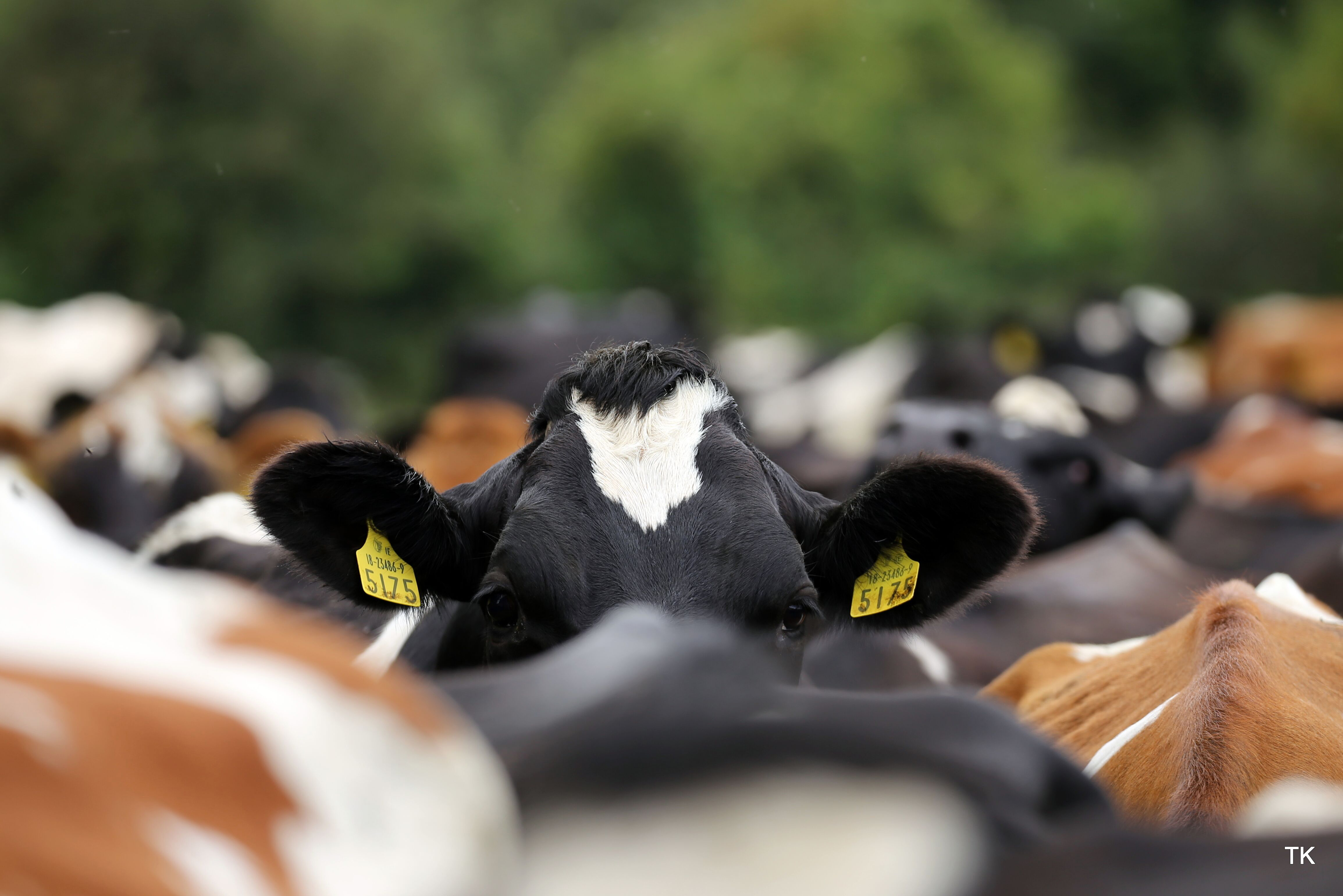
Herd Health Decisions and Tasks for the Dry Period

Munster Bovine Launches New Website
